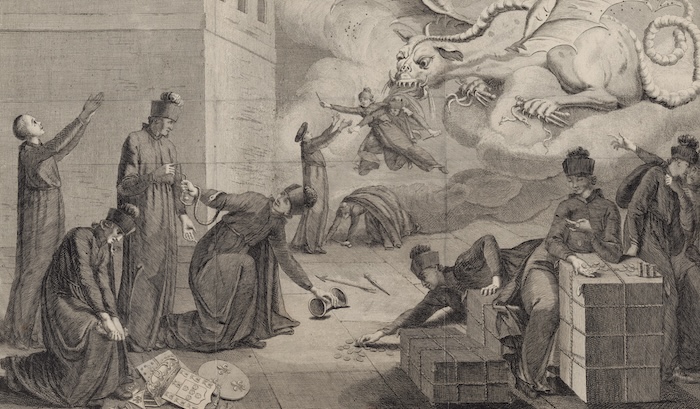In 1767 King Carlos III of Spain decided to expel the Jesuits—a religious order within the Catholic Church—from Spanish lands. But the Empire of Spain spanned the globe, from South America east all the way to the Philippines, and Carlos wanted to make sure none of them escaped to go underground. So he sent secret messages, their contents unknown even to their bearers on penalty of death, to all be unsealed, globally, on the same day. It’s kind of like Star Wars’ Order 66, ordering the execution of the Jedi, but made more gameable by having to work within real-world logistical constraints. Mexico makes a really cool case study!
This post is brought to you by beloved Patreon backer Colin Wixted. Thanks for helping keep the lights on! If you want to help keep this blog going alongside Colin, head over to the Patreon page – and thank you!

To understand why Carlos III wanted to expel the Jesuits, we have to go back to their origins in 1540. Their founder, St. Ignatius of Loyola, was a former soldier who organized the order with military discipline. Members of the order did not and do not report to the local religious hierarchy (the bishop of the lands in which they work), but rather to their own internal Jesuit hierarchy, which then reports to the Pope. In Imperial Spain, the local Catholic hierarchies worked hand-in-glove with secular authorities, which meant the Jesuits essentially operated outside the system. Instead, they had their own system, over which King Carlos had less control than he wanted. Jesuits were also unusually powerful. Many worked as missionaries to the Native nations in lands far from government control. Others worked as tutors to the sons of the wealthy, which gave the order connections and influence. The Jesuits hadn’t caused any problems in the Spanish Empire (as far as I’m aware), but their autonomy, discipline, connections, and distance from scrutiny meant they could if they wanted to.
Mistrust of the Jesuit order was common at the time. They’d already been thrown out of Portugal and France. Even the Pope was souring on them. In other times, popes used the order (which reported directly to them) as their personal bulldogs, entrusted with responsibilities bishops couldn’t be relied upon to handle. But Pope Clement XIV was working to improve relations with the Catholic monarchs of Europe. Those monarchs were centralizing authority and didn’t like the Jesuits much, so Clement didn’t either.
King Carlos III was consolidating power, and he didn’t like having a separate power structure operating within his empire. So he resolved to get rid of the Jesuits. But how to do so? Spain ruled lands across the globe. Once word got out what he was doing, Jesuits across the empire would go into hiding. The King didn’t want that to happen. Instead, on February 27, 1767, he sent out sealed orders. Printed on the outside was a warning not to open them before nightfall on April 2nd, on pain of execution.
The orders for Mexico didn’t arrive until May. Communication across oceans was hard, and in the 18th century, how long it took ships to cross was variable. (Orders didn’t arrive in the Philippines until the next year). By the time the viceroy governing Mexico learned what he was to do, the nationwide roundup had already happened in mainland Spain. The Mexican viceroy, the Marquis de Croix (a Frenchman by birth), told only two other people about his orders: his nephew and his right-hand man, José de Gálvez. Together, the three of them planned how they would arrest and deport an entire religious order.

José de Gálvez, the viceroy’s right-hand man, is a fascinating figure. He came from a family of farmers. People like him did not normally hold power in Imperial Spain. But Gálvez was brilliant. While he was still in school, a passing bishop remarked upon Gálvez’s exceptional intelligence and sponsored him to become a lawyer. Gálvez set up shop in Madrid and married a relative of the French ambassador. She finagled to get him into government. Once he had his foot in the door, he bought officers’ commissions in the army for his male relatives, dragging the whole family into the upper crust along with him. Because Gálvez didn’t have a cushy estate to return to, he volunteered for arduous duties—and the rewards that came with them—that officials born into money routinely turned down. Gálvez was in Mexico to act as the auditor to the viceroy. Indeed, when he arrived in Mexico in 1765 (two years before the Jesuit roundup), he found that the then-viceroy had been lying to the King about conditions there to make himself look good. The viceroy and Gálvez butted heads for a year until the viceroy was recalled, replaced by the Marquis de Croix, with whom Gálvez had already established a political alliance. The Marquis turned things around, and Gálvez, who was ostensibly there to watch him, was instead his closest and most trusted peer.
The three conspirators distributed sealed orders across Mexico in the same manner as the King had, not to be opened until June 24th, 1767. They anticipated the roundup would trigger riots; the Jesuits were popular, and unrest was already widespread. So they recalled the army from its far-flung posts to Mexico City (the capital) and Puebla, to suppress any riots in those two critical cities. The night the orders were unsealed, all the Jesuits in Mexico City were swiftly rounded up. In the Native nations, where there was often only one Jesuit in the whole region, government officials sent riders to arrest them. In the mining regions, there were riots in San Luis de la Paz, Guanajuato, Pátzcuaro, and San Luis de Potosí. Word reached some of these communities faster than anticipated, and people hid Jesuit priests and attacked prisons to free those who’d been arrested. The viceroy dispatched Gálvez to put down this revolt. He had eighty rebels hanged, and hundreds more condemned to the mines. Arrested Jesuits were escorted to the port of Veracruz, and then shipped back to Spain for further exile.
The expulsion of the Jesuits from Mexico was unpopular among most Mexicans. The poor liked that the Jesuits generally treated them better than most of the Church elites did. The rich liked that the Jesuits tutored their sons, and as a consequence many of their sons had themselves become Jesuits. Unrest in Mexico, already high, only intensified in the year following the Jesuit expulsion. Nonetheless, the mission worked. The Marquis and Gálvez got most of their targets. The order in Mexico ceased to be a rival to royal control. And the Crown got to seize the order’s valuable property. Further Jesuit expulsions followed in Europe, culminating in Pope Clement XIV dissolving the order in 1773. It would be restored in 1814. The Jesuit order continues to operate today, and is probably best-known for its work in education.

At your table, the expulsion of the Jesuits from Mexico is a cool adventure hook, whichever side you put your players on. In your fictional campaign setting, a regimented religious order devoted to education and proselytization, is probably something your PCs will have strong opinions about, whether good or bad. Introduce the religious order one or two sessions before you introduce the expulsion plot hook, so that the players can develop some opinions about the priests. Maybe the party meets a tutor or a missionary, and they’re either nice or a jerk. Maybe the party receives shelter at a school.
A few sessions later, the party stumbles upon a messenger who died of a heart attack (or whose spaceship suffered a life support failure), while carrying one of the “do not open before this date under pain of death” sealed orders. If the PCs open it (and c’mon, who’d leave that sealed?), what do they do with the information contained within? If they bring it to its intended recipient, she’ll probably involve the party in the scheme, since they’re already in on the secret. If they bring word to the religious order, the priests will probably ask the PCs’ help in going into hiding. Either way, the party has made new friends and new enemies, which can have repercussions that reverberate through the rest of the campaign.
————
Make sure you don’t miss a blog post by subscribing to my no-frills, every-other-week mailing list! I also have a signup that’s only for big product releases!
Looking for material for your game tonight? My back catalog has hundreds of great posts, all searchable and filterable so you can find something from real history or folklore that fits exactly what you need! Posts older than a year are behind a very cheap paywall – only $2/month!
Come follow and chat with me on social media! On Mastodon I’m @MoltenSulfur@dice.camp. On Twitter, I’m @moltensulfur. On Blue Sky, I’m @moltensulfur.bsky.social.
Enjoy this post? Consider sharing it on social media, or maybe emailing it to a GM friend of yours. The social media infrastructure that creators relied upon to grow their audiences is collapsing. You sharing my stuff helps me stay relevant and ultimately helps me get paid for my time.
Check out Shanty Hunters, my award-winning TTRPG about collecting magical sea shanties in the year 1880, then singing them at the table with your friends. The lyrics of the shanties come to life and cause problems for you and for the crew of the ship you sail aboard. It’s up to you to find clues in the song and put things right!







